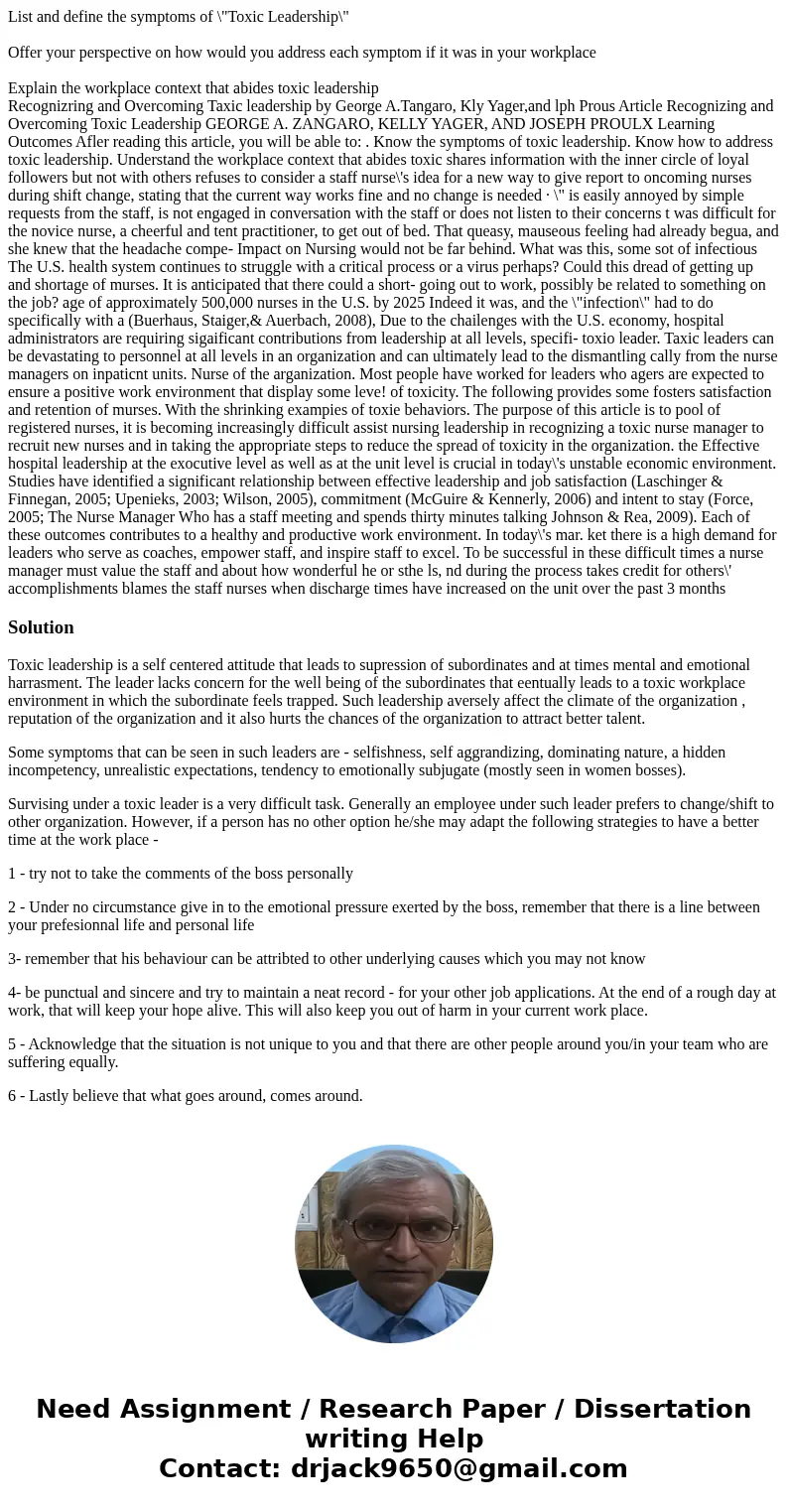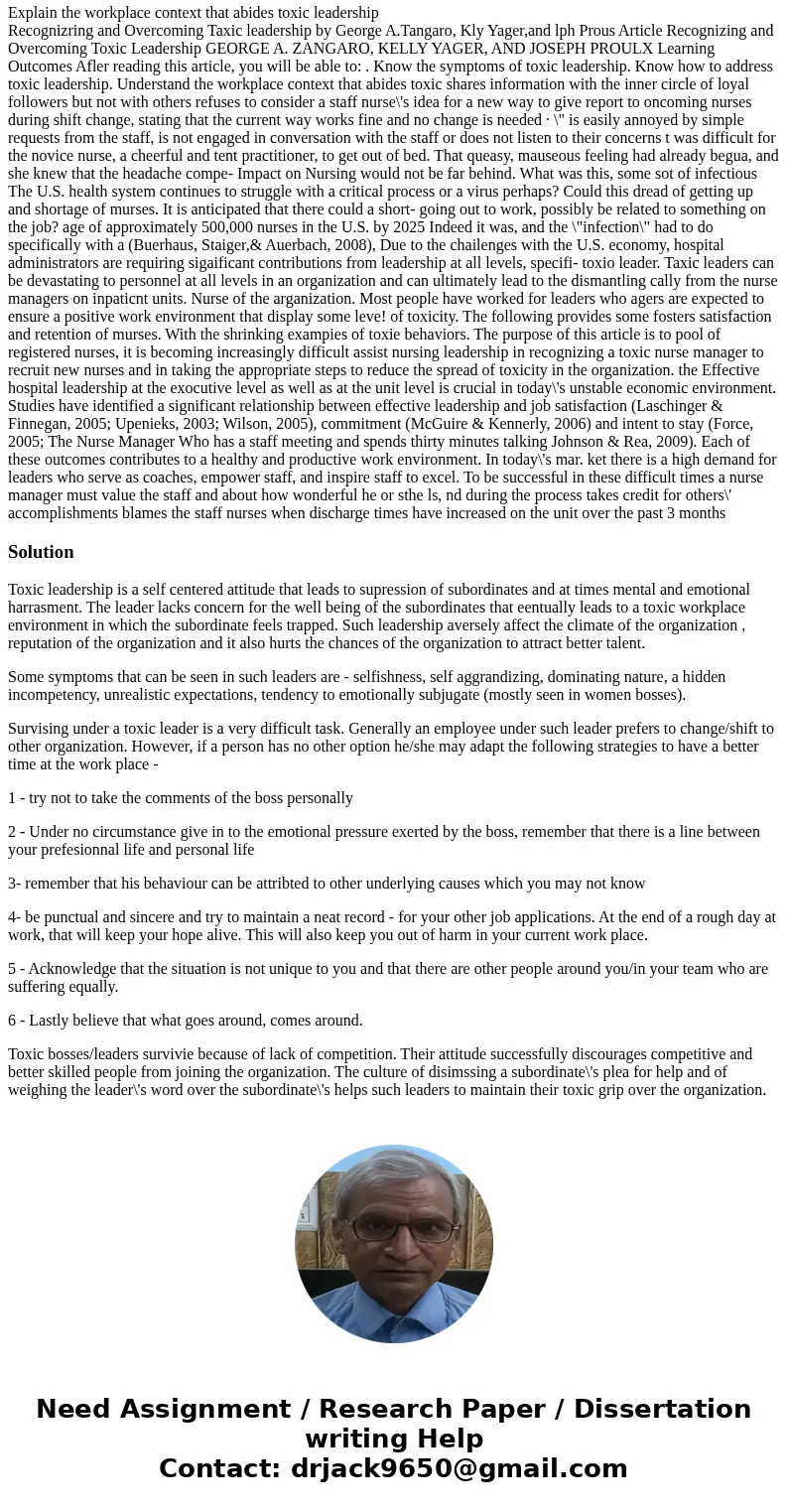List and define the symptoms of \"Toxic Leadership\"
Offer your perspective on how would you address each symptom if it was in your workplace
Explain the workplace context that abides toxic leadership
Recognizring and Overcoming Taxic leadership by George A.Tangaro, Kly Yager,and lph Prous Article Recognizing and Overcoming Toxic Leadership GEORGE A. ZANGARO, KELLY YAGER, AND JOSEPH PROULX Learning Outcomes Afler reading this article, you will be able to: . Know the symptoms of toxic leadership. Know how to address toxic leadership. Understand the workplace context that abides toxic shares information with the inner circle of loyal followers but not with others refuses to consider a staff nurse\'s idea for a new way to give report to oncoming nurses during shift change, stating that the current way works fine and no change is needed · \" is easily annoyed by simple requests from the staff, is not engaged in conversation with the staff or does not listen to their concerns t was difficult for the novice nurse, a cheerful and tent practitioner, to get out of bed. That queasy, mauseous feeling had already begua, and she knew that the headache compe- Impact on Nursing would not be far behind. What was this, some sot of infectious The U.S. health system continues to struggle with a critical process or a virus perhaps? Could this dread of getting up and shortage of murses. It is anticipated that there could a short- going out to work, possibly be related to something on the job? age of approximately 500,000 nurses in the U.S. by 2025 Indeed it was, and the \"infection\" had to do specifically with a (Buerhaus, Staiger,& Auerbach, 2008), Due to the chailenges with the U.S. economy, hospital administrators are requiring sigaificant contributions from leadership at all levels, specifi- toxio leader. Taxic leaders can be devastating to personnel at all levels in an organization and can ultimately lead to the dismantling cally from the nurse managers on inpaticnt units. Nurse of the arganization. Most people have worked for leaders who agers are expected to ensure a positive work environment that display some leve! of toxicity. The following provides some fosters satisfaction and retention of murses. With the shrinking exampies of toxie behaviors. The purpose of this article is to pool of registered nurses, it is becoming increasingly difficult assist nursing leadership in recognizing a toxic nurse manager to recruit new nurses and in taking the appropriate steps to reduce the spread of toxicity in the organization. the Effective hospital leadership at the exocutive level as well as at the unit level is crucial in today\'s unstable economic environment. Studies have identified a significant relationship between effective leadership and job satisfaction (Laschinger & Finnegan, 2005; Upenieks, 2003; Wilson, 2005), commitment (McGuire & Kennerly, 2006) and intent to stay (Force, 2005; The Nurse Manager Who has a staff meeting and spends thirty minutes talking Johnson & Rea, 2009). Each of these outcomes contributes to a healthy and productive work environment. In today\'s mar. ket there is a high demand for leaders who serve as coaches, empower staff, and inspire staff to excel. To be successful in these difficult times a nurse manager must value the staff and about how wonderful he or sthe ls, nd during the process takes credit for others\' accomplishments blames the staff nurses when discharge times have increased on the unit over the past 3 months
Toxic leadership is a self centered attitude that leads to supression of subordinates and at times mental and emotional harrasment. The leader lacks concern for the well being of the subordinates that eentually leads to a toxic workplace environment in which the subordinate feels trapped. Such leadership aversely affect the climate of the organization , reputation of the organization and it also hurts the chances of the organization to attract better talent.
Some symptoms that can be seen in such leaders are - selfishness, self aggrandizing, dominating nature, a hidden incompetency, unrealistic expectations, tendency to emotionally subjugate (mostly seen in women bosses).
Survising under a toxic leader is a very difficult task. Generally an employee under such leader prefers to change/shift to other organization. However, if a person has no other option he/she may adapt the following strategies to have a better time at the work place -
1 - try not to take the comments of the boss personally
2 - Under no circumstance give in to the emotional pressure exerted by the boss, remember that there is a line between your prefesionnal life and personal life
3- remember that his behaviour can be attribted to other underlying causes which you may not know
4- be punctual and sincere and try to maintain a neat record - for your other job applications. At the end of a rough day at work, that will keep your hope alive. This will also keep you out of harm in your current work place.
5 - Acknowledge that the situation is not unique to you and that there are other people around you/in your team who are suffering equally.
6 - Lastly believe that what goes around, comes around.
Toxic bosses/leaders survivie because of lack of competition. Their attitude successfully discourages competitive and better skilled people from joining the organization. The culture of disimssing a subordinate\'s plea for help and of weighing the leader\'s word over the subordinate\'s helps such leaders to maintain their toxic grip over the organization.


 Homework Sourse
Homework Sourse